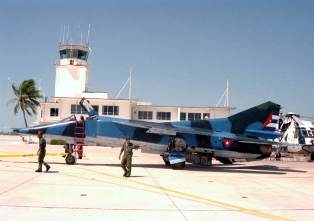Soviet MiG aircraft have been used by the Cuban military since 1961, when the USSR sent several MiG-15s to Cuba about a month after the Bay of Pigs incident. The time was the height of the Cold War, with the Cuban Missile Crisis just around the corne
The history of the Soviet MiG aircraft in Cuba could fill a thick book. First arriving in Cuba in 1961 after the Bay of Pigs incident, 24 MiG 15s made up Cuba’s squadrons from the beginning of the Cold War. Though Cuba has had military trainer aircraft from Czechoslovakia, variations of MiGs were their mainstay and still are. Though Cuba used many versions of the MiG over the decades, including the MiG 21, 23, and 29, this article will focus only on the MiG-17 and the MiG-23.
In 1964 Cuba received several MiG-17AS and MiG-17Fs to substitute for the MiG-15s of earlier years. These planes were to be used as fighter-bombers. Though some sources say that Cuba also received the MiG17PF, there is no confirmation of that. The MiG-17AS were capable of shooting air to air missiles, and Cuba was one of only a few countries who received them. The MiG-17s were used in Cuba until the beginning of the 1980s, which was after Cuba’s engagement in Angola. By that time, MiG-23s were gradually taking over the MiG-17′s work. However, the MiG-17 was the standard fighter-bomber of the Revolutionary Armed Forces (FAR) until 1978.
Cuban MiG-17s were perhaps most famous for an incident in 1969 when a MiG-17 pilot named Eduardo Guerra Jimenez landed in Florida in a MiG-17AS. A squadron leader in the Santa Clara MiG-17AS Regiment, Guerra Jimenez was testing out a repaired plane and landed on Homestead AFB in Florida, a total surprise to the Americans. Coincidentally, President Lyndon B. Johnson’s personal Boeing 707 happened to be there, which did nothing to calm the nerves of Cold War America. After Guerra Jimenez’ desertion, Cuba purged the FAR, kicking out friends of Guerra Jimenez, and those with relatives living abroad.
That MiG-17 was returned to Cuba, and the transport plane that came to get it was accused of “accidentally” overflying several sensitive airspaces, like the nuclear plant at Turkey Point.
In 1975, Castro sent a squadron of nine MiG-17Fs and one MiG15UTI to Angola. They were destined to become the first aircraft of the Angolan Air Force, which happened to be made up of Cubans. MiG-17Fs fought in the northern part of Angola while MiG-21MFs fought in the south until victory was declared in April 1976. Eventually the MiG-17s were delivered to the Angolans after Cuba had enough MiG-21s to make them superfluous.
It was June of 1978 that the FAR received its first MiG-23s. Specifically, they accepted 14 MiG-23BN Flogger planes. The planes made their debut in a military parade in January 1979, the 20th anniversary of the revolution. Despite gloomy weather, 9 MiG-23BNs in three troikas made several passes over Revolution Square, much to the Castro brothers’ delight.
In 1996, a MiG-23 acted as a radio relay station between ground radar controllers while a MiG-29 that shot down two Cessna aircraft carrying members of the Cuban exile group “Brothers to the Rescue.” Cuba still has 79 MiG-23s in service, making up 5 squadrons of 5 regiments of the FAR, though many newer models are also part of the FAR.





